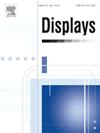Font and background color combinations influence recognition efficiency: A novel method via primary color Euclidean distance and response surface analysis
IF 3.7
2区 工程技术
Q1 COMPUTER SCIENCE, HARDWARE & ARCHITECTURE
引用次数: 0
Abstract
The readability of human–computer interfaces impacts the users’ visual performance while using electronic devices, which gains inadequate attention. This situation is critical during high-stress conditions such as firefighting, where accurate and fast information processing is critical. This study addresses how font and background color combinations on Liquid Crystal displays (LCDs) affect recognition efficiency. A novel concept, primary color Euclidean distance (PCED), is introduced and testified under a repeated-measures experiment. Three factors were investigated: background color (black, white), font color (red, green, blue), and PCEDs. A total of 24 participants were recruited. Results demonstrate that color combinations with specific PCED values can substantially impact recognition efficiency. By using RSA, this study modelled the response time in a generalized mathematical model, which is response surface analysis. Results showed that blue font colors under a black background showed the longest response time. This study also explored the influence of physical stress on recognition efficiency, revealing a latency of about 100 ms across all color combinations. The findings offer a methodological advancement in understanding the effects of color combinations in digital displays, setting the stage for future research in diverse demographic and technological contexts, including mixed reality.

字体和背景颜色组合会影响识别效率:通过原色欧氏距离和响应面分析的新方法
人机界面的可读性会影响用户在使用电子设备时的视觉表现,从而导致注意力不足。在消防等高压力条件下,这种情况至关重要,因为准确快速的信息处理至关重要。本研究探讨了液晶显示器(LCD)上的字体和背景颜色组合如何影响识别效率。研究引入了一个新概念--原色欧氏距离(PCED),并在重复测量实验中进行了验证。实验研究了三个因素:背景颜色(黑、白)、字体颜色(红、绿、蓝)和 PCED。共招募了 24 名参与者。结果表明,特定 PCED 值的颜色组合会极大地影响识别效率。通过使用 RSA,本研究在广义数学模型(即响应面分析)中对响应时间进行了建模。结果显示,黑色背景下蓝色字体的响应时间最长。本研究还探讨了身体压力对识别效率的影响,发现所有颜色组合的延迟时间都在 100 毫秒左右。研究结果为理解数字显示屏中颜色组合的影响提供了一种方法论上的进步,为今后在不同的人口和技术背景下(包括混合现实)开展研究奠定了基础。
本文章由计算机程序翻译,如有差异,请以英文原文为准。
求助全文
约1分钟内获得全文
求助全文
来源期刊

Displays
工程技术-工程:电子与电气
CiteScore
4.60
自引率
25.60%
发文量
138
审稿时长
92 days
期刊介绍:
Displays is the international journal covering the research and development of display technology, its effective presentation and perception of information, and applications and systems including display-human interface.
Technical papers on practical developments in Displays technology provide an effective channel to promote greater understanding and cross-fertilization across the diverse disciplines of the Displays community. Original research papers solving ergonomics issues at the display-human interface advance effective presentation of information. Tutorial papers covering fundamentals intended for display technologies and human factor engineers new to the field will also occasionally featured.
 求助内容:
求助内容: 应助结果提醒方式:
应助结果提醒方式:


